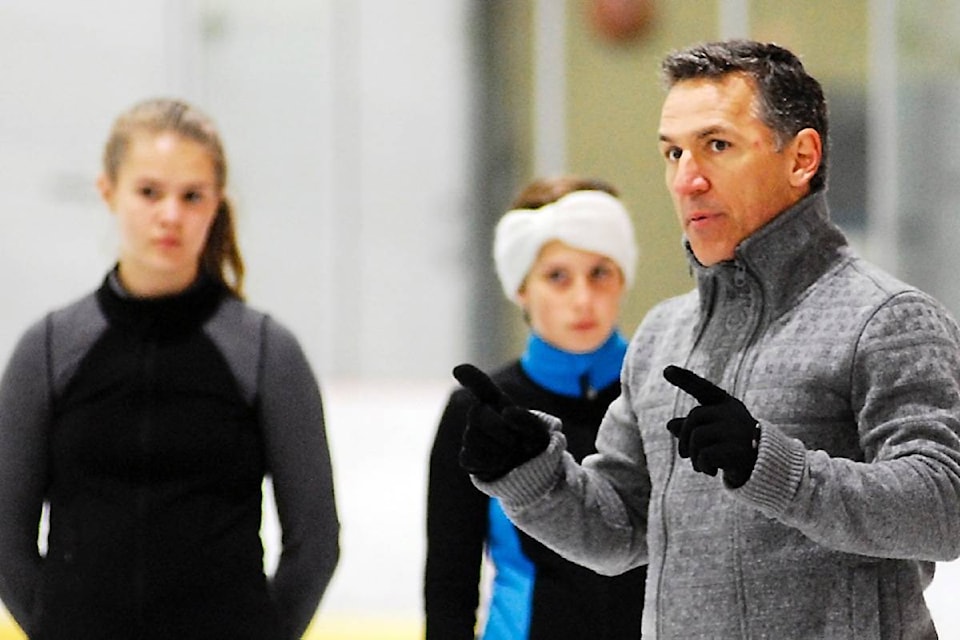When it comes to jumping techniques in figure skating, there’s no question that Elvis Stojko rocks.
He is well-known for his phenomenal high-energy performances that featured electrifying, high-leaping routines. They have greatly helped Stojko reach the upper echelons of figure skating, winning the world championships three times and two Olympic silver medals, and also set a number of firsts in the sport.
To learn how Stojko does it with great efficiency and consistency is a rare opportunity and an experience a lot of young skaters will not forget. That’s what 74 young figure skaters from Vancouver Island received from one of Canada’s figure skating champions at Oceanside Place, Sept. 23-24.
Stojko was in Parksville along with his wife, former Mexican skating champion Gladys Orozco, for a skater development seminar organized by Skate Canada Vancouver Island. And nothing pleases Stojko more than to help the future stars of the sport develop their skills to attain their goals and dreams.
“It feels great to be able to give back all the years of studying and learning from other coaches, and then developing my own techniques and figuring things out for myself,” Stojko told The NEWS.
“To be able to share that with them, to help them out on the road because there’s always going to be pitfalls or things that may be on their way at the time,” he said. “To be part of that and help them find their way and achieve their goals, it’s a great feeling. With me, I learned from so many different people in my career that helped me become a world champion. Hopefully one day, we will have a world champion or two world champions somewhere in that mix.”
Figure skating jumps — salchow, axle, toe loops, etc. — are major elements in figure skating. Stojko said they’re the toughest to learn in the sport.
“My focus is usually getting them set up technically with the jumps,” said Stojko. “That’s the biggest thing because that’s the hardest thing to get. So I worked with them on the jumps and the technique for that.”
Victoria skater and coach Jacob Der Helst was awed by the techniques and knowledge that Stojko shared during the seminar.
“I can’t really describe it,” said Der Helst. “I have learned a lot of new things and new ways to approach some things. He has seen a lot so he is able to pick the best of the best and being able to bring all that together, and teach that, is good.”
These days, Stojko keeps busy holding seminars through Skate Canada, particularly during the fall and winter months as he no longer competes. However, he admits to having mixed feelings about not competing anymore.
“I miss competing. Yeah, that’s always going to be a part of me,” said Stojko. “But the stress of it is so high and I remember when I watch it. There are moments of it that I miss and other moments that I am glad I am not in it anymore. It’s so exhausting. It’s a very, very difficult place to be.”
The popularity of figure skating has waned over the years. Changes are being implemented to the sport, said Stojko, but it will be tough to bring it back to the impressive level that the sport enjoyed during its glory years in the early 1990s.
“I know we’ve lost a lot of fans over the years,” said Stojko. “You are always gonna have a core group of fans to stay and watch it, no matter what. What makes it tough is we’ve lost the people that enjoyed skating but they weren’t super fans. They don’t follow it all the time but they watch the Olympics and World Championships. We’ve lost a lot of that general audience.”
Stojko said the decline in fan base could be attributed to incidents like the Tonya Harding-Nancy Kerrigan incident in 1994, the 2002 Winter Olympics figure skating scandal, and also the controversial scoring system.
“I know they are working hard to make it better for audience appeal or make it more fair in a way for everybody. That’s the trick. How do you do it?” said Stojko.
Figure skating has evolved with the introduction of quads and triple-triple combinations. They have made the sport a lot more exciting and awesome for fans to watch and enjoy, said Stojko. Making the elements appealing to fans is important.
“Without an audience watching it, it doesn’t get out there, right?” said Stojko.
